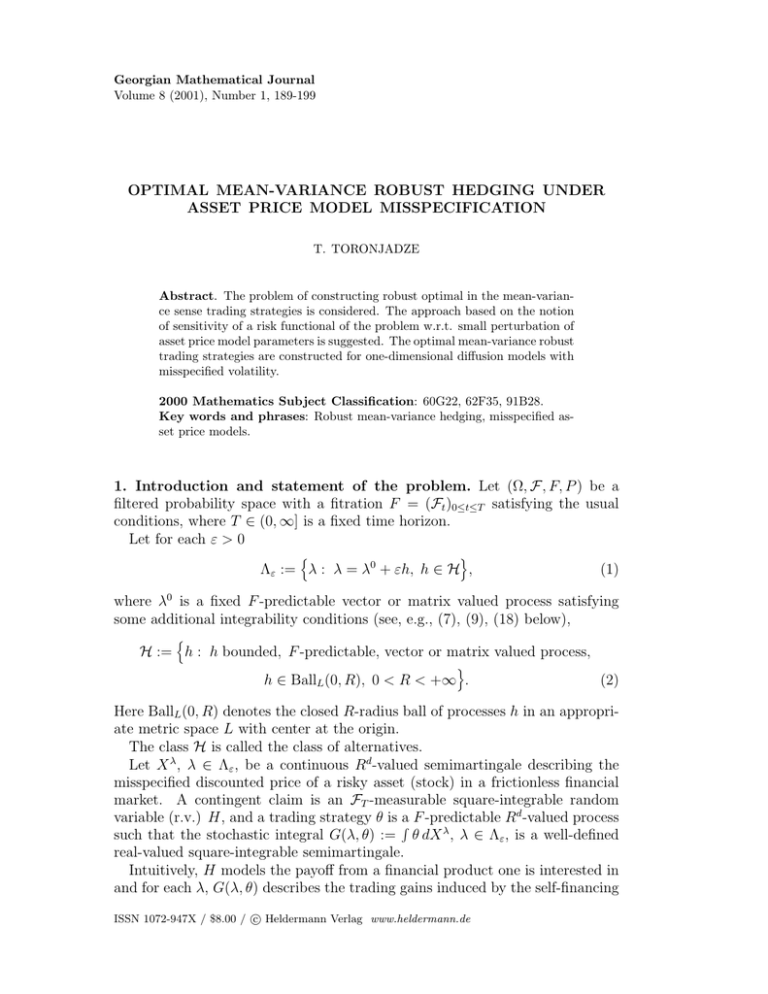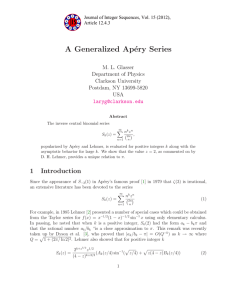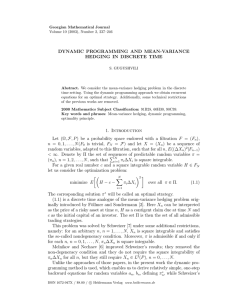OPTIMAL MEAN-VARIANCE ROBUST HEDGING UNDER ASSET PRICE MODEL MISSPECIFICATION
advertisement

Georgian Mathematical Journal
Volume 8 (2001), Number 1, 189-199
OPTIMAL MEAN-VARIANCE ROBUST HEDGING UNDER
ASSET PRICE MODEL MISSPECIFICATION
T. TORONJADZE
Abstract. The problem of constructing robust optimal in the mean-variance sense trading strategies is considered. The approach based on the notion
of sensitivity of a risk functional of the problem w.r.t. small perturbation of
asset price model parameters is suggested. The optimal mean-variance robust
trading strategies are constructed for one-dimensional diffusion models with
misspecified volatility.
2000 Mathematics Subject Classification: 60G22, 62F35, 91B28.
Key words and phrases: Robust mean-variance hedging, misspecified asset price models.
1. Introduction and statement of the problem. Let (Ω, F, F, P ) be a
filtered probability space with a fitration F = (Ft )0≤t≤T satisfying the usual
conditions, where T ∈ (0, ∞] is a fixed time horizon.
Let for each ε > 0
n
o
Λε := λ : λ = λ0 + εh, h ∈ H ,
(1)
where λ0 is a fixed F -predictable vector or matrix valued process satisfying
some additional integrability conditions (see, e.g., (7), (9), (18) below),
n
H := h : h bounded, F -predictable, vector or matrix valued process,
o
h ∈ BallL (0, R), 0 < R < +∞ .
(2)
Here BallL (0, R) denotes the closed R-radius ball of processes h in an appropriate metric space L with center at the origin.
The class H is called the class of alternatives.
Let X λ , λ ∈ Λε , be a continuous Rd -valued semimartingale describing the
misspecified discounted price of a risky asset (stock) in a frictionless financial
market. A contingent claim is an FT -measurable square-integrable random
variable (r.v.) H, and a trading strategy θ is Ra F -predictable Rd -valued process
such that the stochastic integral G(λ, θ) := θ dX λ , λ ∈ Λε , is a well-defined
real-valued square-integrable semimartingale.
Intuitively, H models the payoff from a financial product one is interested in
and for each λ, G(λ, θ) describes the trading gains induced by the self-financing
c Heldermann Verlag www.heldermann.de
ISSN 1072-947X / $8.00 / °
190
T. TORONJADZE
portfolio strategy associated with θ when the asset price process follows the
semimartingale X λ .
For each λ ∈ Λε , the total loss of a hedger, who srarts with the initial capital
x, uses the strategy θ, believes that the stock price process follows X λ and has
to pay a random amount H at the date T , is thus H − x − GT (λ, θ).
The robust mean-variance hedging means solving the optimization problem
³
´2
minimize sup E H − x − GT (λ, θ)
over all strategies θ.
(3)
λ∈Λε
Denote by J(λ, θ) the risk functional of problem (3),
³
´2
J(λ, θ) := E H − x − GT (λ, θ) ,
and consider the following approximation (which is common in the robust statistics theory, see, e.g., [1], [2]):
n
o
sup J(λ, θ) = exp sup ln J(λ0 + εh; θ)
λ∈Λε
(
h∈H
·
DJ(λ0 , h; θ)
' exp sup ln J(λ , θ) + ε
J(λ0 , θ)
h∈H
( sup DJ(λ0 , h; θ) )
,
= J(λ0 , θ) exp ε h∈H
J(λ0 , θ)
¸)
0
where
DJ(λ0 , h; θ) :=
¯
d
J(λ0 + εh; θ) − J(λ0 , θ)
¯
J(λ0 + εh; θ)¯
,
= lim
ε=0
ε→0
dε
ε
(4)
is the Gateaux differential of the functional J at the point λ0 in the direction
h.
Our approach consists in approximating (in the leading order ε) the optimization problem (3) by the problem
( sup DJ(λ0 , h; θ) )
minimize J(λ , θ) exp ε h∈H
0
J(λ0 , θ)
over all strategies θ,
(5)
and note that every solution θ∗ of problem (5) minimizes J(λ0 , θ) under the
constraint
sup DJ(λ0 , h; θ)
sup DJ(λ0 , h; θ∗ )
h∈H
h∈H
≤ k :=
.
J(λ0 , θ)
J(λ0 , θ∗ )
This gives a characterization of an optimal strategy θ∗ of problem (5), and thus
leads to
OPTIMAL MEAN-VARIANCE ROBUST HEDGING
191
Definition 1. The trading strategy θ∗ is called optimal mean-variance robust against the class of alternatives H if it is a solution of the optimization
problem
minimize J(λ0 , θ) over all strategies θ, subject to constraint
sup DJ(λ0 , h; θ)
h∈H
J(λ0 , θ)
≤c
(6)
(c is some general constant).
In the present paper we consider first a simple diffusion model with zero drift
and show (see the Proposition in Section 2) that the solutions of problems (3)
and (6) coincide. Then we pass to a more complicated diffusion model with
nonzero drift and a deterministic mean-variance tradeoff process and solve the
optimization problem (6) which will be at the same time an approximation (in
leading order ε) solution of problem (3) (see the Theorem in Section 3).
The consideration of misspecified asset price models was initiated by Avellaneda et al. [3], Avelaneda and Paras [4], and Avellaneda and Lewicki [5].
They obtained pricing and hedging bounds in markets with bounds on uncertain volatility. El Karoui et al. [6] investigate the robustness of the Black–
Scholes formula, C. Gallus [7] give an estimate of the variance of additional
costs at maturity if the hedger uses the classical Black–Scholes strategy, but
the volatility is uncertain. H. Ahn et al. [8] consider the Black–Scholes model
with misspecified volatility of the form σe 2 = σ 2 + δS(t, x), |S(t, x)| ≤ 1. The
trading strategies are also the Black–Scholes ones, and the risk functional is an
expected exponencial utility. Based on Feynman–Kac formula, they write the
partial differential equation for the corresponding optimization problem whose
solution cannot be obtained in explicit form. Instead, they find an approximate
solution in the functional form.
2. Diffusion model with zero drift. Let a standard Wiener process w =
(wt )0≤t≤T be given on the complete probability space (Ω, F, P ). Denote by
F w = (Ftw , 0 ≤ t ≤ T ) the P -augmentation of the natural filtration Ftw = σ(ws ,
0 ≤ s ≤ t), 0 ≤ t ≤ T , generated by w.
Let the stock price process be modeled by the equation
dXtλ = Xtλ · λt dwt , X0λ > 0, 0 ≤ t ≤ T,
(7)
where λ ∈ Λε , see (1), (2), with
ZT
(λ0t )2 dt < ∞,
0
P -a.s., and h ∈ BallL∞ (dt×dP ) (0, R), 0 < R < ∞. All considered processes are
real-valued.
Denote by Rλ the yield process, i.e.,
dRtλ = λt dwt , R0 = 0, 0 ≤ t ≤ T,
(8)
192
T. TORONJADZE
and let θ = (θt )0≤t≤T be the dollar amount invested in the stock X λ .
Define the class of admissible strategies Θ = Θ(Λε ) = Θ(λ0 , H).
Definition 2. A class of admissible strategies Θ = Θ(λ0 , H) is a class of
F w -predictable real-valued processes θ = (θt )0≤t≤T such that
ZT
ZT
θt2 (λ0t )2
E
dt < ∞,
θt2 h2t dt < ∞, ∀h ∈ H,
E
0
0
or, equivalently,
ZT
ZT
θt2 (λ0t )2
E
θt2 dt < ∞.
dt < ∞, E
0
(9)
0
The corresponding gain process has the form
Zt
θs dRsλ , 0 ≤ t ≤ T,
Gt (λ, θ) =
(10)
0
(recall that θ is the dollar amount invested in the risky asset rather than the
number of shares). Evidently, GT (λ, θ) ∈ L2 (P ) for each λ ∈ Λε . The wealth
at maturity T , with the initial endowment x, is equal to
VTx,θ (λ)
ZT
θt dRtλ .
=x+
0
Let, further, the contingent claim H be FTw -measurable P -square-integrable r.v.
For simplicity, we suppose that a risk-free interest rate r ≡ 0; hence the
corresponding bond price Bt ≡ 1, 0 ≤ t ≤ T .
Consider the optimization problem (3). It is easy to see that if λ ∈ Λε ; then
λ0t − εR ≤ λt ≤ λ0t + εR, 0 ≤ t ≤ T, P -a.s.
By the martingale representation theorem
ZT
ϕH
t dwt , P -a.s.,
H = EH +
(11)
0
where ϕ
H
w
is the F -predictable process with
ZT
2
(ϕH
t ) dt < ∞.
E
(12)
0
Hence
³
E H−
´2
VTx,θ (λ)
ZT
2
(ϕH
t − λt θt ) dt.
2
= (EH − x) + E
0
OPTIMAL MEAN-VARIANCE ROBUST HEDGING
193
From this it directly follows that the process
λ∗t (θ) = (λ0t − εR)I
+ (λ0t + εR)I
ϕH
t
θt
≥λ0t }
ϕH
t
θt
<λ0t }
{
{
I{θt 6=0}
I{θt 6=0} , 0 ≤ t ≤ T,
(13)
is a solution of the optimization problem
³
´2
maximize E H − VTx,θ (λ)
over all λ ∈ Λε , with a given θ ∈ Θ.
It remains to minimize (w.r.t. θ) the expression
ZT ³
E
∗
ϕH
t − λt (θ)θt
´2
dt.
0
From (13) it easily follows that the equation (w.r.t. θ)
∗
ϕH
t − λt (θ)θt = 0,
has no solution, but
θt∗ =
ϕH
t
I 0 , 0 ≤ t ≤ T,
λ0t {λt 6=0}
(14)
solves problem (3). We assume that 0/0 := 0.
Consider now the optimization problem (6).
For each fixed h
µ
ZT
θt dRtλ
J(λ, θ) = E H − x −
¶2
0
Ã
ZT
=E H −x−
dwt − ε
0
θt ht dwt
0
"µ
0
= J(λ , θ) − 2εE
!2
ZT
θt λ0t
EH − x +
ZT ³
ϕH
t
−
θt λ0t
´
#
¶ ZT
dwt
0
θt ht dwt
0
ZT
θt2 h2t dt,
2
+ε E
0
and hence
0
DJ(λ , h; θ) = 2E
ZT ³
0
´
θt λ0t − ϕH
t θt ht dt,
(15)
194
T. TORONJADZE
as follows from (9), (12), the definition of the class H and the estimation
µ
E
ZT ³
θt λ0t
−
ϕH
t
´
¶2
θt ht dt
0
≤E
ZT ³
θt λ0t
−
´2
θtH
ZT
0
Ã
ZT
≤ const ·R2 E
0
!
ZT
θt2 (λ0t )2 dt + E
0
θt2 h2t dt
dt E
ZT
2
(ϕH
t ) dt E
0
θt2 dt < ∞.
(16)
0
Since, further, DJ(λ0 , h; θ) = 0 for h ≡ 0, using (16) we get
0 ≤ sup DJ(λ0 , h; θ) < ∞.
h∈H
Hence we can take 0 ≤ c < ∞ in problem (6). Now if we substitute θ∗ from
(14) into (15), we get DJ(λ0 , h; θ∗ ) = 0 for each h, and thus
sup DJ(λ0 , h; θ∗ )
h∈H
J(λ0 , θ∗ )
= 0.
If we recall that θ∗ = arg min J(λ0 , θ), we get that θ∗ defined by (14) is a
θ∈ΘΛε
solution of the optimization problem (6) as well.
Thus we prove the following
Proposition. In scheme (7), (8) under assumptions (9):
(a) the optimal mean-variance robust trading strategy θ∗ = (θt∗ )0≤t≤T for the
optimization problem (6) is given by the formula
θt∗ =
ϕH
t
I 0 ;
λ0t {λt 6=0}
(b) this strategy is an approximation (in leading order ε) strategy for the
optimization problem (3) and coincides with the exact optimal strategy of this
problem.
3. Diffusion model with nonzero drift. Let us consider the filtered probability space (Ω, F, F w = (Ftw )0≤t≤T , P ) with a given standard Wiener process
w = (wt , Ftw ), 0 ≤ t ≤ T , and a given P -square-integrable FTw -measurable r.v.
H. Let the stock price process be defined by the equation
³
´
dXtλ = Xtλ µt dt + λt dwt , X0λ > 0,
(17)
µt = kt λt , 0 ≤ t ≤ T,
(18)
where
and k = (kt )0≤t≤T is a bounded deterministic function, λ = (λt )0≤t≤T ∈ Λε , i.e.,
λt = λ0t + εht ,
OPTIMAL MEAN-VARIANCE ROBUST HEDGING
195
RT
where λ0 is an F w -predictable process with (λ0t )2 dt < ∞, P -a.s. h ∈ H, with
0
L =L∞ (dt×dP ), i.e., h is a bounded F -pedictable process, h ∈ BallL∞ (dt×dP ) (0,R),
0 < R < +∞. All processes in (17), (18) are real-valued.
Consider the optimization problem (6). Denote, as in the previous section,
by Rλ the yield process defined by the equation
dRtλ = λt (kt dt + dwt ), R0λ = 0, 0 ≤ t ≤ T,
(19)
and for each θ = (θt )0≤t≤T ∈ Θ(λ0 , H) (see Definition 2) introduce the risk
functional of the problem
µ
ZT
θt dRtλ
J(λ, θ) = E H − x −
¶2
.
0
Rt
Note that since the mean-variance tradeoff process ( ks2 ds)0≤t≤T is continuous
0
and bounded, the space {GT (λ, θ) : θ ∈ Θ} is closed in L2 (P ) for each λ ∈ Λε ,
see, e.g., Corollary 4 of [9]. Further, there exists a unique equivalent martingale
measure (which does not depend on the parameter λ) given by the relation
dPe = zeT dP,
where zeT = ET (−k.w), zeT > 0, E zeT = 1, Et (−k.w) is the Dolean exponential of
Rt
the martingale −k.wt = − ks dws , 0 ≤ t ≤ T . Moreover, the process G(λ, θ)
0
belongs to S 2 , the set of square integrable semimartingales, for each λ ∈ Λε .
Now, following [10] and [11], introduce the objects: zet = E Pe(zeT /Ftw ), 0 ≤
2
zT
zT
e (and thus dQ
e = e
e = e
d
P
dP ). Since ze > 0 is a strictly positive
t ≤ T , dQ
e
z0
e
z0
e is a probability measure with Q
e ≈ P.
Pe -martingale, Q
Introduce, further, the process
Zt
wt0
= wt +
ks ds, 0 ≤ t ≤ T.
0
0
Then Ftw = Ftw , 0 ≤ t ≤ T , because k is deterministic, and hence the process
w0 = (wt0 )0≤t≤T is a standard (Pe , F w )-Wiener process. Consider now the new
filtered probability space (Ω, F, F w , Pe ), rewrite the process Rλ in the form
dRtλ = λt dwt0 , R0λ = 0, 0 ≤ t ≤ T,
(20)
and decompose the r.v. zeT w.r.t. w0 :
ZT
ζt dwt0 .
zeT = ze0 +
0
(21)
196
T. TORONJADZE
In this notation, based on Proposition 5.1 of [10], we can write
µ
T
Z
ze2 ze2
J(λ, θ) = E T2 20 H − x − θt dRtλ
ze0 zeT
¶2
0
=
2
e ze
ze0−1 E Q 20
zeT
Ã
=
e
ze0−1 E Q
µ
ZT
¶2
0
H
ze0 − x −
zeT
0
θt λt dwt0
H −x−
ZT
z0
ψt0 (λ) d
zet
e
0
ZT
−
0
w0
ψt1 (λ) d t
zet
!2
ze0
1
:= J(λ, ψ , ψ ).
(22)
Here
Zt
ψt1 (λ)
ψt0 (λ)
= θt λt ,
θs λs dws0 − θt λt wt0 , 0 ≤ t ≤ T.
=x+
0
Thus
0
ψt1 (λ) = ψt1 (λ0 ) + εψt1 (h),
ψt0 (λ) = ψt0 (λ0 ) + εψ t (h),
(23)
0
where ψ t (h) = ψt0 (h) − x.
If now
µ
¶
T
T
Z
Z
e0
w0
H
e H
0,H z
Q
ze0 = E
ze0 + ψt d + ψt1,H d t ze0
zeT
zeT
zet
zet
(24)
0
0
is the Galtchouk–Kunita–Watanabe decomposition of the r.v.
H e
z w.r.t.
e
zT 0
w0
z0
e F w )-local martingales e
(Q,
and eztt ze0 , then, using (22), (23) and (24), we
e
zt
get for each fixed h
0
1
("µ
µ
¶¶
e H
ze0
zeT
#
ZT ³
ZT ³
´ w0
´ ze
0
1,H
0,H
t
0
1 0
0 0
d +
ψt (λ ) − ψt (λ d ze0
+
ψt (λ ) − ψt
zet
zet
³
0
0
0
1
0
´
J(λ, ψ , ψ ) = J λ , ψ (λ ), ψ (λ ) +
e
ε2ze0−1 E Q
0
0
à ZT
×
0
+
x − EQ
ze0
0
ψ t (h) d
zet
e
ε2 ze0−1 E Q
à ZT
0
ZT
+
0
w0
ψt1 (h) d t
zet
ze0
0
ψ t (h) d
zet
ZT
+
0
!)
ze0
w0
ψt1 (h) d t
zet
!2
ze0
.
(25)
OPTIMAL MEAN-VARIANCE ROBUST HEDGING
197
Consequently,
(
0
0
1
2ze0−1
DJ(λ , h; ψ , ψ ) =
E
ZT ³
e
Q
¿
´ 0
ψt0 (λ0 ) − ψt0,H ψ t (h) d
0
+E
e
Q
ZT ·³
ψt1 (λ0 )
−
´ 0
³
ψt1 (λ0 )
ψt1,H
ψt1,H
ψ t (h) +
ψt0 (λ0 )
−
ψt0,H
´
+E
Zt ³
−
´
¿ 0
w
ψt1 (h) d
0
t
zet
À
¸ ¿ 0
w
ze0
d
ze0 ,
zet
zet
À
t
ψt1 (h)
0
e
Q
ze0
zet
À)
ze0
.
(26)
0
From the definition of ψ 1 (h) and ψ (h) (see (23)) it follows that for h ≡ 0,
0
ψ 1 (h) = 0 and ψ (h) = 0. Hence
DJ(λ0 , 0; ψ 0 , ψ 1 ) = 0,
and thus
sup DJ(λ0 , h; ψ 0 , ψ 1 ) ≥ 0.
(27)
h∈H
We show now that
sup DJ(λ0 , h; ψ 0 , ψ 1 ) < ∞.
(28)
h∈H
For this it is sufficient to estimate the expression (as it easily follows from (25))
I=E
e
Q
à ZT
0
ze0
0
ψ t (h) d
zet
ZT
w0
ψ (h) d t ze0
zet
1
+
0
!2
.
But using Proposition 8 of [11], we have for each h
( ZT
=
0
³
´
ze0
GT h, Θ(0, H)
zet
ze0
0
ψ t (h) d
zet
ZT
+
0
¯
µ
w0 ¯
ze0 w0
0
e
ψ 1 (h) d t ze0 ¯¯ ψ (h), ψ 1 (h) ∈ L2
,
ze0 , Q
zet
ze ze
¶)
,
e is the space of F w -predictable processes (ψ 0 , ψ 1 ) such
where L2 ( ezez0 , ez ze0 , Q)
R 0 e
R
0
e F w ) of martingales.
that ψ d zez0 + ψ 1 d wez ze0 is in the space M2 (Q,
Hence, using notation (10), we have
w0
I=
2
e ze
E Q 20
zeT
µ ZT
G2T (h, θ)
=
ze0 EG2T (h, θ)
θt dRth
= ze0 E
0
µ ZT
= ze0 E
¶2
θt ht (kt dt + dwt )
0
¶2
198
T. TORONJADZE
Ã
θt2 h2t kt2
≤ ze0 const · E
µ
≤ ze0 const ·R
θt2 h2t
dt + E
0
2
!
ZT
ZT
dt
0
¶
ZT
θt2 dt < ∞,
E
0
by the definitions of the classes Θ, H, and the boundedness of the function
k = (kt )0≤t≤T .
From (27) and (28), as in the previous section, it follows that we can take
0 ≤ c < ∞ in problem (6).
Now if we substitute ψ 1,∗ (λ0 ) := ψ 1,H and ψ 0,∗ (λ0 ) := ψ 0,H into J(λ0 , ψ 0 , ψ 1 )
and DJ(λ0 , h, ψ 0 , ψ 1 ), we get
³
´
J λ0 , ψ 0,∗ , ψ 1,∗ = min
J(λ0 , ψ 0 , ψ 1 )
0 1
ψ ,ψ
(see Lemma 5.1 of [10]), and
DJ(λ0 , h; ψ 0,∗ , ψ 1,∗ )
=0
J(λ0 , ψ 0,∗ , ψ 1,∗ )
h∈H
sup
(hence the constraint of problem (6) is satisfied).
Consequently, using Proposition 8 of [11], we arrive at the following
Theorem. In model (17)–(19) the optimal mean-variance robust trading
strategy (in the sense of Definition 1) is given by the formula
" 1,H
θt∗
µ
0
e0
ψt
ζt
0,H z
1,H wt
∗
=
+
V
−
ψ
−
ψ
ze0
t
t
t
λ0t
λ0t
zet
zet
where
Ã
Vt∗
t
ψ
and ψ
1,H
I{λ0t 6=0} , 0 ≤ t ≤ T,
!
Z
ze0 Z
w0
ze0
x + ψs0,H d + ψs1,H d s ze0 ,
=
zet
zes
zes
0
0,H
t
¶#
0
are given by relation (24), ζt is defined in (21).
Acknowledgement
This work was supported by INTAS Grants Nos. 97-30204 and 99-00559.
References
1. F. R. Hampel, E. M. Ronchetti, P. J. Rousseeuw, and W. A. Stahel, Robust
statistics. The approach based on influence functionals. John Wiley and Sons, N.Y. etc.,
1986.
2. H. Rieder, Robust asymptotic statistics. Springer-Verlag, N.Y., 1994.
3. M. Avellaneda, A. Levy, and A. Paras, Pricing and hedging derivative securities in
markets with uncertain volatilities. Appl. Math. Finance 2(1995), 73–88.
OPTIMAL MEAN-VARIANCE ROBUST HEDGING
199
4. M. Avellaneda and A. Paras, Managing the volatility of risk of portfolios of derivative
securities: the Lagrangian uncertain volatility model. Appl. Math. Finance 3(1996), 21–
52.
5. M. Avellaneda and P. Lewicki, Pricing interest rate contingent claims in markets
with uncertain volatilities. Preprint, Courant Institute of Mathematical Sciences, New
York University.
6. N. El Karoui, M. Jeanblanc-Picque, and S. E. Shreve, Robustness of the Black
and Scholes formula. Math. Finance 8(1998), No. 2, 93–126.
7. C. Gallus, Robustness of hedging strategies for European options. Engelbert, HansJuergen (ed.) et al., Stochastic processes and related topics. Proceedings of the 10th winter
school, Siegmundsberg, Germany, March 13–19, 1994. Gordon and Breach Publishers.
Stochastics Monogr., Amsterdam 10(1996), 23–31.
8. H. Ahn, A. Muni, and G. Swindle, Misspecified asset price models and robust hedging
strategies. Appl. Math. Finance 4(1997), 21–36.
9. H. Pham, T. Rheinlaender, and M. Schweizer, Mean-Variance hedging for continuous processes: new proofs and examples. Finance Stochs. 2(1998), 173–198.
10. C. Gourieroux, J. P. Laurent, and H. Pham, Mean-variance hedging and numeraire.
Math. Finance 8(1998), No. 3, 179–200.
11. T. Rheinlaender and M. Schweizer, On L2 -projections on a space of stochastic
integrals. Ann. Probab. 25(1997), No. 4, 1810–1831.
(Received 20.11.2000)
Author’s Address:
A. Razmadze Mathematical Institute
Georgian Academy of Sciences
1, M. Aleksidze St., Tbilisi 380093
Georgia
E-mail: toro@imath.acnet.ge





